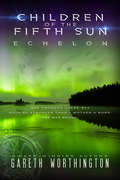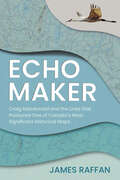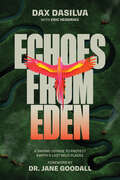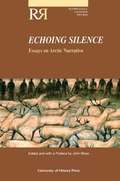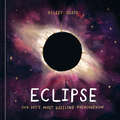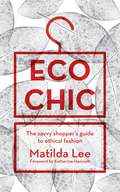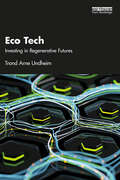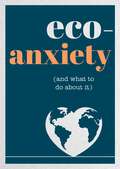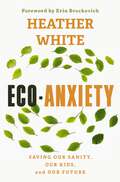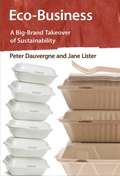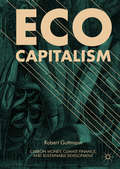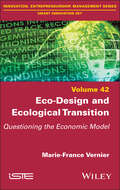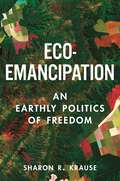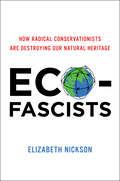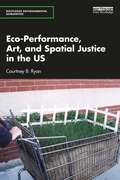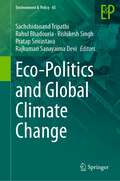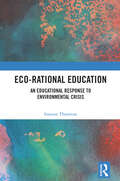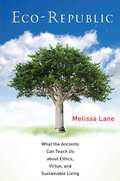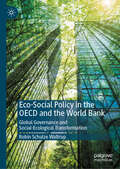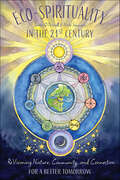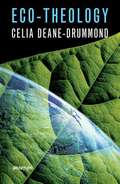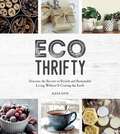- Table View
- List View
Echelon (Children of the Fifth Sun)
by Gareth WorthingtonShe thought there was nothing stronger than a mother’s bond. She was wrong.FIFTEEN THOUSAND YEARS AGO, the knowledge bringers—an amphibious, non-humanoid species known as the Huahuqui—came after a great global flood, gifting humans with math, science, and civility.We killed them all.Seventy years ago, we found one of their corpses preserved in ice and eventually created a clone named K’in. Our governments fought over the creature and we killed it, too. Now, a sinkhole in Siberia has opened, revealing new secrets.FREYA NILSSON spent the last five years trying to forget her role in the Huahuqui cloning program. She hid her son, KJ, from the regimes and agencies she believed would exploit him for the powers he acquired through his father’s bond with K’in.An innocent trip to help KJ understand his abilities results in the conspiracy she fought to bury exploding back to life. Chased by new foes and hounded to put the world first, all Freya can think of is protecting KJ—at all costs.Children of the Fifth Sun: Echelon is the sequel to Gareth Worthington’s multi-award-winning debut novel Children of the Fifth Sun.
Echo Maker: Craig Macdonald and the Lives that Produced One of Canada's Most Significant Historical Maps
by James RaffanIn an example of truth and reconciliation put into practice, Craig Macdonald spent decades creating a unique map of Temagami, developed through trust and experience, in partnership with the Teme-Augama Anishnabai. James Raffan’s biography of Craig Macdonald and how the Historical Map of Temagami came to be is a remarkable tale. In the mid-1960s, Macdonald began interviewing and travelling with Indigenous trappers and travellers. He became familiar with Anishinaabemowin and built a lasting bond with the traditional knowledge holders. Returning year after year to map the land, Macdonald painstakingly plotted traditional placenames, original shorelines, elevations, and traditional summer and winter travel routes — including the documentation of more than twelve hundred canoe portages and winter snowshoe trails. His map is unique in the Canadian cartographic canon, and its genesis is a story that has never been told, until now.
Echoes from Eden: A Daring Voyage to Protect Earth's Last Wild Places
by Eric Hendrikx Dax Dasilva"Echoes from Eden recounts Dax Dasilva&’s journey supporting conservation efforts in the places that need it most. This book is a testament to the power of direct action, a blueprint for environmental conservation, and, as well, a deeply personal exploration of spirituality and Earth stewardship."— Jane Goodall, PhD, DBEAll proceeds from this book will be donated to the Jane Goodall Legacy FundFrom the frontline protests of Clayoquot Sound to the helm of a global tech empire, Dax Dasilva&’s path has always straddled two worlds—innovation and conservation. Echoes from Eden is not just the story of a man who walked away from business as usual; it is a call to arms for the wild.As the world reeled from the pandemic and conservation efforts collapsed, rangers were sent home, funding dried up, and poachers and loggers swept in like vultures. Instead of retreating, Dasilva launched the Age of Union Alliance, committing $40 million to safeguard the planet&’s last wild places. What followed was a journey into the heart of the Earth&’s most endangered landscapes—tracking Grauer&’s gorillas in the Congo with Dr. Kerry Bowman, navigating Amazonian rivers with Paul Rosolie and Junglekeepers, braving militia-held territories in Haiti to protect community forests, and sailing with Sea Shepherd to shut down illegal fishing operations in the Bay of Biscay.Along the way, he met those who risk everything to defend the land: Dr. Jane Goodall and Juma Xipaya in the Amazon, Suzan Baptiste protecting the leatherback turtles of Trinidad, Dr. Russell Mittermeier conserving the endangered lemurs of Madagascar, and the fearless eco-warriors fighting in Indonesia, Canada, and beyond.But Echoes from Eden is more than an expedition log—it is a reckoning. Told with an urgency sharpened by experience, it asks us to see the world as it is: beautiful, brutal, and slipping through our fingers. This isn&’t a plea for awareness—it&’s a battle cry.The time to act isn&’t tomorrow. It&’s now.
Echoing Silence: Essays on Arctic Narrative
by John MossThis book discusses the different generations of explorers and writers and illustrates how the sounds of a landscape are inseparable from the stories of its inhabitants.
Eclipse: Our Sky's Most Dazzling Phenomenon
by Kelsey OseidDiscover the ancient myths and fascinating science of the world&’s most striking celestial phenomena—eclipses—in this educational, beautifully illustrated guide by the acclaimed author of What We See in the Stars.Awe-inspiring, majestic, and always a little otherworldly, eclipses have captivated our imaginations for thousands of years. Whether plunged into darkness as the sun disappears in the middle of the day or enchanted by the moon&’s blood red glow as a vast shadow creeps across its surface, our ancestors both feared and revered eclipses, seeking to understand these striking celestial events through both storytelling and science.In Eclipse, celebrated artist and author Kelsey Oseid explores the science and mystique of lunar and solar eclipses, from the myths of our ancestors to today. Did you know that in Chinese legends, solar eclipses were caused by dragons eating the sun? Or that the Norse people believed that a sky wolf chased away the moon? Oseid presents these rich historical stories alongside informative, accessible science to enrich your understanding: a solar eclipse only occurs during a new moon; a selenelion is when you can see the lunar eclipse in front of you and the sunset behind you; and the Mars Rovers have even taken photographs of eclipses from Mars.Filled with captivating information and vivid, colorful illustrations, Eclipse will delight and inspire astronomy lovers of all ages.
Eco Chic: The savvy shopper's guide to ethical fashion
by Matilda LeeThe hottest trend on the catwalk is ethical clothing. Top fashion designers and spokesmodels including Katharine Hamnett, Stella McCartney and Bono's wife Ali Hewson are all voicing the benefits of eco chic. But what is this new fad, and what difference can it make to the world? "Eco Chic" gives you the full story on this fashion phenomenon, from which fabrics are harmful to the environment, to how you can create your own eco-friendly fashions through recycling and savvy shopping. You will discover how to spot and avoid garments produced in sweatshops and why supermarket 'fast clothes' make both you and the planet sick. This book will allow you to look great but also feel good about your impact on other people and the planet as a whole.
Eco Tech: Investing in Regenerative Futures
by Trond UndheimThe book is a seminal contribution from a leading futurist who, over the past three decades, has explored each of the most disruptive forces shaping our world today, including emerging technologies, entrepreneurship, venture investments, and industrial manufacturing. Eco Tech brings all this thinking together, fusing insight from thought leaders with the author’s own considerable experience, to explore scenarios for 2050 and discuss eco-effectiveness as an established practice for governments, corporations, startups, and individuals. Trond Arne Undheim begins by providing a brief history of sustainability and provides simple definitions for key terms including eco-efficiency, life cycle analysis, industrial ecology, cleantech, net zero, climate change, biodiversity, and carbon capture, which will enable the reader to engage confidently in eco-discussions. Undheim also explores the ambitions of regeneration and offers a new conceptual framework to facilitate future discussion around sustainable innovation. He applies this framework to green, ambitious start-ups and examines the way these ventures will lead the way towards an eco-effective society, drawing on stories from exciting founders who are already changing the world. Finally, the book takes a deep dive into emerging eco-innovations, including batteries, bioplastics, distributed energy, space tech, and futuristic megaprojects. The book contains clear directions on how to progress through adversity and avoid returning to the status quo. The book will be an essential guide for executives, sustainability professionals, and energy tech investors who are deeply concerned with the future and are prepared to both significantly invest in it and make behavioral changes to foster regenerative development. It will also be a great resource for students and scholars of sustainable investing and innovation.
Eco-Anxiety (and What to Do About It): Practical Tips to Allay Your Fears and Live a More Environmentally Friendly Life
by Harriet DyerBe kind to the planet, but most of all, be kind to yourselfWhen you feel the weight of the world on your shoulders, grab this book for a dose of calm and courage. Packed with reassuring tips and advice, from mindfulness exercises to practical steps you can take to make a difference, this guide will ease your eco-anxiety and help you to live a more environmentally friendly life.
Eco-Anxiety: Saving Our Sanity, Our Kids, and Our Future
by Heather WhiteThe climate crisis and its resulting eco-anxiety is the biggest challenge of our time. The anxiety that comes with worrying about how environmental harm will impact our--and our children's--lives can be overwhelming. Learn how to balance practicing daily sustainability actions while caring for your own eco-anxiety in this revolutionary book from noted environmentalist Heather White.In Eco-Anxiety, White shows you how to contribute to the climate movement through self-discovery and self-care. Utilizing the Service Superpower Profile Assessment included in the text, you&’ll discover how your personality, interests, and strengths can be of service to others and the planet. This book will serve as your guide to:Begin a 21-Day Kickstarter Plan that shares specific sustainable actions you can takeTrack your progress with journal prompts and exercises that'll help you measure mental health benefitsListen and talk with loved ones about their climate anxietyCommit to being an eco-aware individual and inspire your family, friends, and community to work toward a regenerative, sustainable worldSetting the intention each day to take a small step to care for the planet--can help ease your eco-anxiety, push the culture toward climate solutions, and create a sense of joy.One Green Thing>
Eco-Business
by Peter Dauvergne Jane ListerMcDonald's promises to use only beef, coffee, fish, chicken, and cooking oil obtained from sustainable sources. Coca-Cola promises to achieve water neutrality. Unilever has set a deadline of 2020 to reach 100 percent sustainable agricultural sourcing. Walmart has pledged to become carbon neutral. Today, big-brand companies seem to be making commitments that go beyond the usual "greenwashing" efforts undertaken largely for public relations purposes. In Eco-Business, Peter Dauvergne and Jane Lister examine this new corporate embrace of sustainability, its actual accomplishments, and the consequences for the environment. For many leading-brand companies, these corporate sustainability efforts go deep, reorienting central operations and extending through global supply chains. Yet, as Dauvergne and Lister point out, these companies are doing this not for the good of the planet but for their own profits and market share in a volatile, globalized economy. They are using sustainability as a business tool. Advocacy groups and governments are partnering with these companies, eager to reap the governance potential of eco-business efforts. But Dauvergne and Lister show that the acclaimed eco-efficiencies achieved by big-brand companies limit the potential for finding deeper solutions to pressing environmental problems and reinforce runaway consumption. Eco-business promotes the sustainability of big business, not the sustainability of life on Earth.
Eco-Business: A Big-Brand Takeover of Sustainability (The\mit Press Ser.)
by Peter Dauvergne Jane ListerTwo experts explain the consequences for the planet when corporations use sustainability as a business tool.McDonald's promises to use only beef, coffee, fish, chicken, and cooking oil obtained from sustainable sources. Coca-Cola promises to achieve water neutrality. Unilever seeks to achieve 100 percent sustainable agricultural sourcing by 2020. Walmart has pledged to become carbon neutral. Big-brand companies seem to be making commitments that go beyond the usual “greenwashing” efforts undertaken largely for public-relations purposes. In Eco-Business, Peter Dauvergne and Jane Lister examine this new corporate embrace of sustainability, its actual accomplishments, and the consequences for the environment. For many leading-brand companies, these corporate sustainability efforts go deep, reorienting central operations and extending through global supply chains. Yet, as Dauvergne and Lister point out, these companies are doing this not for the good of the planet but for their own profits and market share in a volatile, globalized economy. They are using sustainability as a business tool. Dauvergne and Lister show that the eco-efficiencies achieved by big-brand companies limit the potential for finding deeper solutions to pressing environmental problems and reinforce runaway consumption. Eco-business promotes the sustainability of big business, not the sustainability of life on Earth.
Eco-Capitalism: Carbon Money, Climate Finance, and Sustainable Development
by Robert GuttmannOur planet faces a systemic threat from climate change, which the world community of nations is ill-prepared to address, and this book argues that a new form of ecologically conscious capitalism is needed in order to tackle this serious and rising threat. While the Paris Climate Agreement of 2015 has finally implemented a global climate policy regime, its modest means belie its ambitious goals. Our institutional financial organizations are not equipped to deal with the problems that any credible commitment to a low-carbon economy will have to confront. We will have to go beyond cap-and-trade schemes and limited carbon taxes to cut greenhouse gas emissions substantially in due time. This book offers a way forward toward that goal, with a conceptual framework that brings environmental preservation back into our macro-economic growth and forecasting models. This framework obliges firms to consider other goals beyond shareholder value maximization, outlining the principal tenets of a climate-friendly finance and introducing a new type of money linked to climate mitigation and adaptation efforts.
Eco-Design and Ecological Transition: Questioning the Economic Model
by Marie-France VernierSuccessive IPCC reports consistently stress the devastating impact of human activity on the climate. An ecological transition seems essential to modify our economic and social system, while meeting the needs of current and future generations. As the main culprits of environmental destruction, companies must modify their production methods to reduce their negative impact on the environment. Eco Design and Ecological Transition presents an innovative approach to eco design, a method that aims to offer products or services with a reduced environmental impact compared to conventional production methods, from the extraction of resources to the end of the product’s life. The book also analyzes the potential of the circular economy and frugal innovation. It shows that innovation, to be sustainable, must be both environmentally and socially sustainable. From a systemic point of view, it examines the ability of players, particularly companies, to change their strategies in order to combine human well-being and respect for the environment in the context of ecological transition.
Eco-Emancipation: An Earthly Politics of Freedom
by Sharon R. KrauseThe case for an eco-emancipatory politics to release the Earth from human domination and free us all from lives that are both exploitative and exploitedHuman domination of nature shapes every aspect of our lives today, even as it remains virtually invisible to us. Because human beings are a part of nature, the human domination of nature circles back to confine and exploit people as well—and not only the poor and marginalized but also the privileged and affluent, even in the world’s most prosperous societies. Although modern democracy establishes constraints intended to protect people from domination as the arbitrary exercise of power, it offers few such protections for nonhuman parts of nature. The result is that, wherever we fall in human hierarchies, we inevitably find ourselves both complicit in and entrapped by a system that makes sustainable living all but impossible. It confines and exploits not only nature but people too, albeit in different ways. In Eco-Emancipation, Sharon Krause argues that we can find our way to a better, freer life by constraining the use of human power in relation to nature and promoting nature’s well-being alongside our own, thereby releasing the Earth from human domination and freeing us from a way of life that is both exploitative and exploited, complicit and entrapped. Eco-emancipation calls for new, more-than-human political communities that incorporate nonhuman parts of nature through institutions of representation and regimes of rights, combining these new institutional arrangements with political activism, a public ethos of respect for nature, and a culture of eco-responsibility.
Eco-Fascists: How Radical Conservationists Are Destroying Our Natural Heritage
by Elizabeth NicksonForty million Americans have been driven from their lands and rural culture is being systematically crushed, even as wildlife, forests, and rangelands are dying. Journalist Elizabeth Nickson’s investigations into these events have revealed a shocking truth: rather than safeguarding our environment, radical conservationists are actually destroying our natural heritage. In Eco-Fascists, Nickson documents the destructive impact of the environmental movement in North America and beyond, detailing the extreme damage environmental radicals in local and national government agencies are doing to the land, the ecosystems, and the people. Readers of Alston Chase’s Playing God in Yellowstone and In a Dark Wood, and anyone who is deeply concerned about global warming and the environment must read Elizabeth Nickson’s Eco-Fascists.
Eco-Friendly Adhesives for Wood and Natural Fiber Composites: Characterization, Fabrication and Applications (Composites Science and Technology)
by Mohammad Jawaid Mohammad Asim Mohammed Nasir Tanveer Ahmed KhanThis book provides an overview of eco-friendly resins and their composite materials covering their synthesis, sources, structures and properties for different industrial applications to support the ongoing research and development in eco-friendly and renewable commercial products. It provides comparative discussions on the properties of eco-friendly resins with other polymer composites. It is a useful reference on bio-based eco-friendly polymer resins, wood-based composites, natural fibers and biomass materials for the polymer scientists, engineers and material scientists.
Eco-Performance, Art, and Spatial Justice in the US (Routledge Environmental Humanities)
by Courtney B. RyanIn Eco-Performance, Art, and Spatial Justice in the US, Courtney B. Ryan traces how urban artists in the US from the 1970s until today contend with environmental domestication and spatial injustice through performance. In theater, art, film, and digital media, the artists featured in this book perform everyday, spatialized micro-acts to contest the mutual containment of urbanites and nonhuman nature. Whether it is plant artist Vaughn Bell going for a city stroll in her personal biosphere, photographer Naima Green photographing Black urbanites in lush New York City parks, guerrilla gardeners launching seed bombs into abandoned city lots, or a satirical tweeter parodying BP’s response to the 2010 Deepwater Horizon oil spill, the subjects in this book challenge deeply engrained Western directives to domesticate nonhuman nature. In examining how urban eco-artists perform alternate ecologies that celebrate the interconnectedness of marginalized human, vegetal, and aquatic life, Ryan suggests that small environmental performances can expose spatial injustice and increase spatial mobility. Bringing a performance perspective to the environmental humanities, this interdisciplinary text offers readers stymied by the global climate crisis a way forward. It will appeal to a wide range of students and academics in performance, media studies, urban geography, and environmental studies.
Eco-Politics and Global Climate Change (Environment & Policy #65)
by Rishikesh Singh Rahul Bhadouria Sachchidanand Tripathi Pratap Srivastava Rajkumari Sanayaima DeviThis book provides an in-depth insight into the ecological perspective on a number of ongoing issues pertaining to security, the economy, the state, global environmental governance, development, and the environment. The chapters critically compare and analyze the role of global eco-politics in understanding and sorting out issues linked with climate change. Furthermore, it presents a contemporary and accessible description of why we need to embrace eco-politics in order to address the various ecological challenges that we face in the current changing climate scenario.
Eco-Rational Education: An Educational Response to Environmental Crisis
by Simone ThorntonEco-Rational Education proposes an educational response to climate change, environmental degradation, and human relations to ecology through the delivery of critical land-responsive environmental education. The book argues that education is a powerful vehicle for both social change and cultural reproduction. It proposes that the prioritisation and integration of environmental education across the curriculum is essential to the development of ecologically rational citizens capable of responding to the environmental crisis and an increasingly changing world. Using philosophical analysis, particularly environmental philosophy, pragmatism, and ecofeminism, the book develops an understanding of contemporary issues in education, especially inquiry-based learning as pedagogy, diversifying knowledge, environmental and epistemic justice, climate change education, and citizenship education. Eco-Rational Education will be of interest to researchers and post-graduate students of social and political philosophy, educational philosophy, as well as environmental, ethics and teacher education.
Eco-Republic: What the Ancients Can Teach Us about Ethics, Virtue, and Sustainable Living (Peter Lang Ltd Ser. #23)
by Melissa LaneAncient lessons for sustainable citizenshipAn ecologically sustainable society cannot be achieved without citizens who possess the virtues and values that will foster it, and who believe that individual actions can indeed make a difference. Eco-Republic draws on ancient Greek thought—and Plato's Republic in particular—to put forward a new vision of citizenship that can make such a society a reality. Melissa Lane develops a model of a society whose health and sustainability depend on all its citizens recognizing a shared standard of value and shaping their personal goals and habits accordingly. Bringing together the moral and political ideas of the ancients with the latest social and psychological theory, Lane illuminates the individual's vital role in social change, and articulates new ways of understanding what is harmful and what is valuable, what is a benefit and what is a cost, and what the relationship between public and private well-being ought to be.Eco-Republic reveals why we must rethink our political imagination if we are to meet the challenges of climate change and other urgent environmental concerns. Offering a unique reflection on the ethics and politics of sustainability, the book goes beyond standard approaches to virtue ethics in philosophy and current debates about happiness in economics and psychology. Eco-Republic explains why health is a better standard than happiness for capturing the important links between individual action and social good, and diagnoses the reasons why the ancient concept of virtue has been sorely neglected yet is more relevant today than ever.
Eco-Social Policy in the OECD and the World Bank: Global Governance and Social-Ecological Transformation
by Robin Schulze WaltrupThis book explores eco-social policy and its role in the global governance system. By focusing on the eco-social policy discourses of the Organisation for Economic Co-operation and Development (OECD) and the World Bank, this book provides a comprehensive analysis of how and to what extent these influential international organisations integrate environmental and social concerns and promote an integrated eco-social policy perspective. While the OECD and the World Bank promote crucial elements of eco-social policy integration, the book argues that they fall short of pushing toward a social-ecological transformation within global governance that profoundly focuses on the decommodification of nature and labour. Drawing on different concepts, including Polanyi's notion of the double movement, it shows how there are partly contradictory policy perspectives on eco-social policy integration in both organisations, which eventually stabilise the existing capitalist mode of production, albeit with green conditions. Through its in-depth exploration of the eco-social policy discourses of the OECD and the World Bank, this book serves as an essential resource for understanding and questioning the scope of sustainable and equitable global policy frameworks for both researchers and practitioners.
Eco-Spirituality in the 21st Century: ReVisioning Nature, Community, and Connection for a Better Tomorrow
by Dana O'Driscoll Nate SummersEco-Spirituality offers a new vision for nature spirituality both by drawing upon ancient, ancestral connections and by visioning human-nature-spirit connections for a brighter future. The authors combine their collective skill sets in druidry, wilderness survival skills, permaculture, and more, to create this new framework for engaging in an eco-centric spiritual practice and lifestyle in the 21st century. This in-depth guide explores seven principles for reenvisioning humans&’ relationship with the living earth: Reconnection, Respect, Rewilding, Regeneration, Resilience, Reenchantment, and Revisioning. Each principle is introduced through storytelling and then discovered through the Bard, Ovate, and Druid framework, detailing exercises the reader can engage in to experience the principle through creative, explorative, interpersonal, and spiritual actions. Readers will explore how to • build community around nature-based ceremony, cultural sharing, and experiences in the wild; • develop meaningful skill sets such as permaculture, survival, and ancestral skills; • tap into the primordial energy of the Earth and nature through ceremony and meditation; • use ceremony to rejuvenate and regenerate the natural world; • reconnect with nature in meaningful ways, including building ecological knowledge; • rewild their lives with wild movement and creativity, and connecting to nature&’s rhythms; and • tend and regenerate their local ecosystems and communities. With Eco-Spirituality, discover a guide to a more meaningful, connected, and future-oriented nature spirituality.
Eco-Theology
by Celia Deane-DrummondHere is comprehensive coverage of the rapidly growing field of eco-theology. Eco-Theology evaluates the merits or otherwise of contemporary eco-theologies and introduces readers to critical debates, while tracing trends from around the globe and key theological responses. The emphasis is on the theological aspects of Christian engagement with environmental issues, rather than primarily ethical or spiritual concerns. Included are further reading sections and discussion questions.
Eco-Thrifty: Discover the Secrets to Stylish and Sustainable Living Without it Costing the Earth, Including Upcycling, Recycling, Budget-Friendly Ideas and More
by Alexa KayeLiving well doesn’t have to cost the earthWe all want to do our bit for the planet, and now it’s easier than ever. This book is your guide to eco-thrifty living: the way to look out for the climate and your budget at the same time. Explore the art of recycling and upcycling to spruce up your home and garden, find out how to revamp old clothes and how to say no to waste, and learn the secrets to conscious, creative living – all without the hefty price tag.There is no planet B, but with eco-thrifty living, we won’t need one. From nifty cleaning tips, to stylish home decor and natural beauty, discover the countless ways to reduce your carbon footprint and live a life you love that’s sustainable – both for the world and your wallet.
Eco-Trauma Cinema (Routledge Advances in Film Studies)
by Anil NarineFilm has taken a powerful position alongside the global environmental movement, from didactic documentaries to the fantasy pleasures of commercial franchises. This book investigates in particular film’s complex role in representing ecological traumas. Eco-trauma cinema represents the harm we, as humans, inflict upon our natural surroundings, or the injuries we sustain from nature in its unforgiving iterations. The term encompasses both circumstances because these seemingly distinct instances of ecological harm are often related, and even symbiotic: the traumas we perpetuate in an ecosystem through pollution and unsustainable resource management inevitably return to harm us. Contributors to this volume engage with eco-trauma cinema in its three general forms: accounts of people who are traumatized by the natural world, narratives that represent people or social processes which traumatize the environment or its species, and stories that depict the aftermath of ecological catastrophe. The films they examine represent a central challenge of our age: to overcome our disavowal of environmental crises, to reflect on the unsavoury forces reshaping the planet's ecosystems, and to restructure the mechanisms responsible for the state of the earth.
